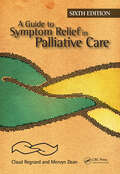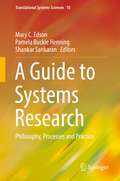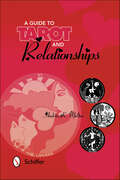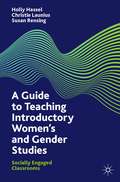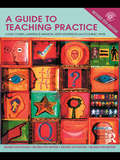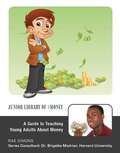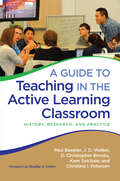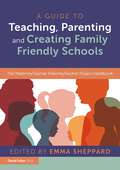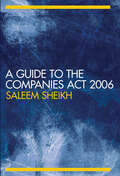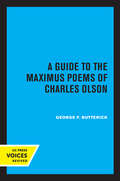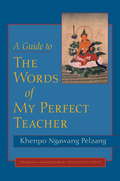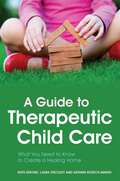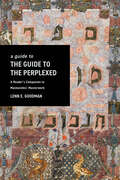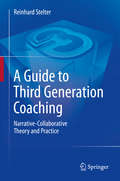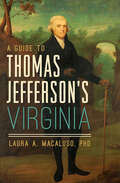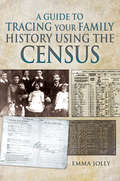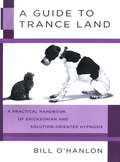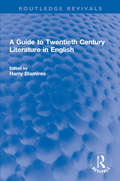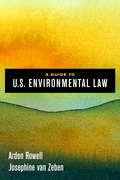- Table View
- List View
A Guide to Symptom Relief in Palliative Care, 6th Edition
by Claude Regnard Mervyn DeanThis established and well-regarded Guide describes the management of patients with advanced disease. Its foundation is a clinical decision-making approach in which the patient's information guides the professional's approach to appropriate management. This Sixth Edition has been fully updated, reflecting the latest advances in knowledge and care of cancer and non-cancer patients with advanced disease, including children and people with severe communication difficulties. Sections on symptoms other than pain and emergencies are set out alphabetically, with the Emergencies section now located at the end of the book for ease of reference. The Drug Information section has been extensively updated, and colour and design refinements introduced throughout for greater clarity and emphasis. All references continue to be categorised to make their evidence base clearer. Maintaining the high standard set by previous editions over the past quarter-century, this continues to be the definitive guide to palliative care symptom relief for professionals in a wide variety of caring environments.
A Guide to Systems Research: Philosophy, Processes and Practice (Translational Systems Sciences #10)
by Mary C. Edson Pamela Buckle Henning Shankar SankaranThis guide is designed for systems researchers - emerging and seasoned - searching for holistic approaches of inquiry into complexity, which the Systems Sciences provide. The authors share insight into the foundations of research that are not only systematic in terms of rigor, but systemic in perspective, analysis, design, development, implementation, reporting, and evaluation. This guide also explores researcher competencies necessary to conduct sound systems research. Researchers using this guide will gain understanding of what distinguishes systems research from other types of research and why it is important in research today.
A Guide to Tarot and Relationships
by Andria K. MolinaUse the Tarot to bring about and enhance all of your relationships! Conscious thought process can be reflected through the symbolism and the language of Tarot – now, via your specialized card readings, you can identify key issues and helping aids to repair or improve your personal relationships. Enable patterns of constructive development into your psyche, find answers for love and self exploration, or discover time frames for events that affect your relationships. A Questions Statement is applied to each card to help you identify questions and to creatively form compelling answers. In addition to metaphorical meanings for each card, a general significance section is included for usage with other life issues. Modern-style illustrations by artist Delores Fitchie accompany the instructions.
A Guide to Teaching Effective Seminars: Conversation, Identity, and Power
by Susan R. FiksdalA Guide to Teaching Effective Seminars provides college and university faculty with a new approach to thinking about their teaching and helps them develop a deeper understanding of conversation itself. Seminars often inspire collaborative learning and produce rich educational environments, yet even experienced faculty find these conversations can range in quality. A Guide to Teaching Effective Seminars addresses this challenge by presenting a sociolinguistic perspective on seminars and providing instructors with best practices to manage successful seminars. Grounded in research, data, and her own deep experience teaching seminars, author Susan Fiksdal reveals ways students negotiate perspectives on reading, on conversation, and on social identities and power. By giving readers an appreciation of the discourse of seminars, the book helps to undermine stereotypes about language and people, increase civility, reduce misunderstandings, and foster tolerance for new ideas and diverse ways of expressing them. This important resource is for faculty members at all levels of experience and in every discipline who want practical advice about facilitating effective seminars. Special Features: Each chapter explores a key aspect of conversation with examples from a wide range of seminars across disciplines. Transcripts from videotaped seminars showcase authentic conversations and negotiations between students. End-of-chapter best practices promote critical thinking and collaboration. A companion website features video clips of the transcripts in the book and additional resources.
A Guide to Teaching Introductory Women’s and Gender Studies: Socially Engaged Classrooms
by Christie Launius Holly Hassel Susan RensingThis book provides a practical, evidence-based guide to teaching introductory Women's and Gender Studies courses. Based on the findings of a Scholarship of Teaching and Learning project that analyzed 72 Intro students’ written work, the authors equip instructors with key principles that can help them adapt their pedagogy to a range of classroom environments. By putting student learning at the center of course design, the authors invite readers to reflect on their own investments in and goals for the introductory course. The book also draws on the authors’ combined decades of teaching experience, and aims to help instructors anticipate the emotional, intellectual, and interpersonal challenges and rewards of teaching and learning in the introductory WGS course. Chapters focus on course design, including identifying desired learning outcomes (in terms of course content, skills, and dispositions or habits of mind); choosing course materials; pedagogical activities; and assessing student learning. This book will be an invaluable resource for experienced WGS instructors and those seeking or planning to teach it for the first time, including graduate students and high school teachers.
A Guide to Teaching Practice: 5th Edition
by Dominic Wyse Louis Cohen Lawrence Manion Keith MorrisonA Guide to Teaching Practice is the major standard text for all students on initial teacher training courses in the UK.Authoritative yet accessible, it covers the important basic skills and issues that students need to consider during their practice, such as planning, classroom organization, behaviour management and assessment. The book's focus on the quality of teaching and learning and consideration of the latest regulations and guidelines ensures that it fits comfortably within TTA and OfSTED frameworks.In addition, comprehensively revised and fully updated, this fifth edition features brand new chapters on the foundation stage, legal issues, learning and teaching and using ICT in the classroom, as well as new material on numeracy, literacy, children's rights, progress files and gifted and talented children.This book is the most respected and widely used textbook for initial teacher training courses and will be an essential resource for any student teacher.
A Guide to Teaching Young Adults About Money
by Rae SimonsParents and teachers can help young people understand the complex world of money and finance--and give them a head start in establishing good financial habits. This guide offers parents and educators resources and discussion topics for materials covered in The Junior Library of Money.
A Guide to Teaching in the Active Learning Classroom: History, Research, and Practice
by D. Christopher Brooks Paul Baepler J. D. Walker Kem Saichaie Christina I. PetersenWhile Active Learning Classrooms, or ALCs, offer rich new environments for learning, they present many new challenges to faculty because, among other things, they eliminate the room’s central focal point and disrupt the conventional seating plan to which faculty and students have become accustomed.The importance of learning how to use these classrooms well and to capitalize on their special features is paramount. The potential they represent can be realized only when they facilitate improved learning outcomes and engage students in the learning process in a manner different from traditional classrooms and lecture halls.This book provides an introduction to ALCs, briefly covering their history and then synthesizing the research on these spaces to provide faculty with empirically based, practical guidance on how to use these unfamiliar spaces effectively. Among the questions this book addresses are:• How can instructors mitigate the apparent lack of a central focal point in the space?• What types of learning activities work well in the ALCs and take advantage of the affordances of the room?• How can teachers address familiar classroom-management challenges in these unfamiliar spaces?• If assessment and rapid feedback are critical in active learning, how do they work in a room filled with circular tables and no central focus point?• How do instructors balance group learning with the needs of the larger class?• How can students be held accountable when many will necessarily have their backs facing the instructor?• How can instructors evaluate the effectiveness of their teaching in these spaces?This book is intended for faculty preparing to teach in or already working in this new classroom environment; for administrators planning to create ALCs or experimenting with provisionally designed rooms; and for faculty developers helping teachers transition to using these new spaces.
A Guide to Teaching, Parenting and Creating Family Friendly Schools: The MaternityTeacher PaternityTeacher Project Handbook
by Emma SheppardAt The MTPT Project we know that teaching can be a sustainable career choice for parents, and in this essential handbook, we show you how. Supported by case studies celebrating the best that the family friendly schools and happy teachers in our community have to offer, this book is a lifeline for both educators aspiring to combine their passion for teaching with becoming a parent, and the school leader who wants to empower them. However you become a parent, or choose to grow your family and your career, this handbook will provide you with the guidance and cheerleading that you need to fulfil your personal and professional aspirations. The book is divided into nine chapters, guiding readers from the first considerations of family planning, all the way through to the reality that some teachers and leaders may choose to leave classrooms for good. Each chapter includes: the latest research on working families legalities associated with different stages of working parenthood (including discrimination and how to avoid it as an employer and address it as an employee) case studies from our community suggestions for individuals and schools recommended further reading. Each chapter will help you to navigate the journey from planning a family, to stepping in and out of teaching to suit your parenting needs, to creating family friendly working environments, whatever your role in school. With its mixture of research-informed solutions, hints and tips, this text is perfect for colleagues embarking on their parenting journey and school leaders who want to take practical steps to retain and empower valued colleagues.
A Guide to The Companies Act 2006
by Saleem SheikhAn easy to use guide to the Companies Act 2006 and packed full of helpful features, this book provides detailed commentary on the new Companies Act. Offering a chapter by chapter analysis of the legal and practical implications of the Act, the author traces the background to the act, considering the various Consultation Documents and White Papers issued by the Government, the proposals for company law reform and their culmination in the Company Law Reform Act. It contains: helpful checklists for the busy practitioner section by section commentary useful appendices of materials and extracts on an accompanying Companion Website. This is an invaluable and handy resource for undergraduate students and practitioners studying or working in business and company law.
A Guide to The Maximus Poems of Charles Olson
by George F. ButterickThis title is part of UC Press's Voices Revived program, which commemorates University of California Press’s mission to seek out and cultivate the brightest minds and give them voice, reach, and impact. Drawing on a backlist dating to 1893, Voices Revived makes high-quality, peer-reviewed scholarship accessible once again using print-on-demand technology. This title was originally published in 1978.
A Guide to The Odyssey: A Commentary on the English Translation of Robert Fitzgerald
by Ralph HexterFor those of us who know and love the incomparable Odyssey of Homer (and there are many), Dr. Hexter has created a valuable, detailed analysis, taking into account many of Homer's most fascinating subtleties.
A Guide to The Uncitral Arbitration Rules
by Christopher Kee Clyde Croft Christopher Kee Jeffrey Waincymer Clyde CroftThe first version of the UNCITRAL Arbitration Rules was endorsed by the General Assembly of the United Nations in December 1976. Now considered one of UNCITRAL's greatest successes, the rules have had an extraordinary impact on international arbitration as both instruments in their own right and as guides for others. The Iran-US Claims Tribunal, for example, employs a barely modified version of the rules for all claims, and many multilateral and bilateral foreign investment treaties adopt the UNCITRAL Rules as an arbitral procedure. The Rules are so pervasive and the consequences of the new version potentially so significant that they cannot be ignored. This commentary on the Rules brings the official documents together in one volume and includes the insights and experiences of the Working Group that are not included in the official reports.
A Guide to The Words of My Perfect Teacher
by Khenpo Ngawang PelzangThis guide provides readers with essential background information for studying and practicing with Patrul Rinpoche's Words of My Perfect Teacher—the text that has, for more than a century, served as the reliable sourcebook to the spiritual practices common to all the major schools of Tibetan Buddhism. By offering chapter-by-chapter commentary on this renowned work, Khenpo Pelzang provides a fresh perspective on the role of the teacher; the stages of the path; the view of the Three Jewels; Madhyamika, the basis of transcendent wisdom; and much more.
A Guide to Theological Reflection: A Fresh Approach for Practical Ministry Courses and Theological Field Education
by Jim Wilson Earl WaggonerFeedback and evaluation, both of oneself and by others, are the lifeblood of a successful ministry experience. In A Guide to Theological Reflection, experienced practical ministry professors Jim Wilson and Earl Waggoner introduce the processes and tools of theological reflection for ministry.Effective evaluation includes critique and potential course correction for the honest and willing minister, as well as positive affirmation of how one's desires influence good ministry decisions. A Guide to Theological Reflection introduces tools by which a minister can interact with his or her own thoughts, beliefs, and feelings; external feedback, such as that of a ministry supervisor; and Scripture to inform deep and transformative theological reflection.Designed as a textbook for practical ministry courses and theological field education, A Guide to Theological Reflection can also be used in ministry contexts. It provides guidance for students, ministers-in-training, mentors, and advisors, laying a theoretical foundation for theological reflection and demonstrating step-by-step how to practice it well.
A Guide to Therapeutic Child Care: What You Need to Know to Create a Healing Home
by Autumn Roesch-Marsh Ruth Emond Laura SteckleyA Guide to Therapeutic Child Care provides an easy to read explanation of the secrets that lie behind good quality therapeutic child care. It describes relevant theories, the 'invisible' psychological challenges that children will often struggle with and how to develop a nurturing relationship and build trust. Combining advice with practical strategies, the book also provides specific guidance on how to create safe spaces (both physical and relational) and how to aid the development of key social or emotional skills for children which may be lacking as a result of early trauma. Written with input from foster carers, the book is an ideal guide for residential child care workers, foster carers, kinship carers, social workers and new adoptive parents.
A Guide to The Guide to the Perplexed: A Reader’s Companion to Maimonides’ Masterwork
by Lenn GoodmanIn this volume, noted philosopher Lenn E. Goodman shares the insights gained over a lifetime of pondering the meaning and purpose of Maimonides' celebrated Guide to the Perplexed. Written in the late twelfth century, Maimonides' Guide aims to help religiously committed readers who are alive to the challenges posed by reason and the natural sciences to biblical and rabbinic tradition. Keyed to the new translation and commentary by Lenn E. Goodman and Phillip I. Lieberman, this volume follows Maimonides' life and learning and delves into the text of the Guide, clearly explaining just what Maimonides means by identifying the Talmudic Ma'aseh Bereshit and Ma'aseh Merkavah with physics and metaphysics (to Maimonides, biblical cosmology and theology). Exploring Maimonides' treatments of revelation, religious practice and experience, law and ritual, the problem of evil, and the rational purposes of the commandments, this guide to the Guide explains the tactics Maimonides deployed to ensure that readers not get in over their heads when venturing into philosophical deep waters.
A Guide to Third Generation Coaching: Narrative-Collaborative Theory and Practice
by Reinhard StelterThis book proposes third generation coaching in a form where the coach and the coaches are less concerned with solutions and more concerned with creating space for (self-)reflection through collaborative practices. Offering a revisited and innovative approach to coaching psychology, advantageous for learners and practitioners alike. It marks a new trend in coaching and has a special profile, based on the acknowledgement of changes in society, learning and knowledge production, as well as leadership. The author' s concept of coaching distinguishes itself from the existing models (pop coaching , GROW model, etc) by offering a fresh analysis of our society - a society that is characterised by diversification, identity challenges, abolition of the monopoly of knowledge, lifelong learning, the necessity for self-reflection, etc. These societal changes are the basis for the existence of coaching and its prevalence, but they must also be the foundation for the way we employ coaching.
A Guide to Thomas Jefferson's Virginia: History Through Architecture (Landmarks Ser.)
by Laura A. MacalusoTour Thomas Jefferson&’s Virginia, from Monticello to the Blue Ridge Mountains and beyond, with a guide that &“mixes historical background with how-tos&” (Daily Press). Few prominent Americans are as associated with a place as Thomas Jefferson is with Virginia. The heart of &“Jefferson Country&” is his house and plantation at Monticello, but Jefferson traveled the breadth of his home state, from his time at the College of William and Mary in Williamsburg to the new state capital at Richmond and his retreat and plantation at Poplar Forest, near Lynchburg. While spending time in the beauty of the Blue Ridge Mountains, Jefferson was inspired to write his only book, Notes on the State of Virginia. Jefferson&’s life story, and his many endeavors as a scholar and statesman, are illustrated in this guide to the state he held dear. &“This book mixes historical background with the how-tos of visiting the places Jefferson spent time, including the Wren Building at the College of William and Mary, which he attended, and the George Wythe house, where he studied law in Williamsburg.&” —Daily Press
A Guide to Tracing Your Family History Using the Census
by Emma JollyHow to use British census records in your genealogical research—includes an appendix of key resources.The census is an essential survey of our population, and it is a source of basic information for local and national government and for various organizations dealing with education, housing, health and transport. Providing the researcher with a fascinating insight into who we were in the past, Emma Jolly’s new handbook is a useful tool for anyone keen to discover their family history. With detailed, accessible and authoritative coverage, it is full of advice on how to explore and get the most from the records.Each census from 1841 to 1911 is described in detail, and later censuses are analyzed too. The main focus is on the census in England and Wales, but censuses in Scotland, Ireland, the Channel Islands and the Isle of Man are all examined and the differences explained. Particular emphasis is placed on the rapidly expanding number of websites that offer census information, making the process of research far easier to carry out. The extensive appendix gathers together all the key resources in one place.Emma Jolly’s guide is an ideal introduction and tool for anyone who is researching the life and times of an ancestor.
A Guide to Trance Land: A Practical Handbook of Ericksonian and Solution-Oriented Hypnosis
by Bill O'Hanlon<P> A friendly and brief guide to the essentials of hypnosis. <P> Popular author Bill O’Hanlon offers an inviting and reassuring guide to the essentials of hypnosis, alleviating the newcomer’s anxieties about how to make the most of this clinical tool. This brief book illustrates the benefits of solution-oriented hypnosis, which draws on the work of the pioneering therapist Milton Erickson (with whom O’Hanlon studied) and emphasizes doing what is needed to get results—which, more often than not, means trusting that the client holds within him- or herself answers or knowledge that need only be tapped or released by the therapist. <P> O’Hanlon covers the key aspects of hypnosis, including: using possibility words and phrases; using passive language; and inducing trance. O’Hanlon offers practical tips and friendly encouragement for the novice hypnotherapist—in his characteristic warm, reassuring, and humorous style.
A Guide to Treatments that Work
by Peter E. Nathan Jack M. GormanLike its predecessors, this fourth edition of A Guide to Treatments That Work offers detailed chapters that review the latest research on pharmacological and psychosocial treatments that work for the full range of psychiatric and psychological disorders, written in most instances by clinical psychologists and psychiatrists who have been major contributors to that literature. Similarly, the standards by which the authors were asked to evaluate the methodological rigor of the research on treatments have also remained the same. Each chapter in A Guide to Treatments That Work follows the same general outline: a review of diagnostic cues to the disorder, a discussion of changes in the nomenclatures from DSM-IV to DSM-5, and then a systematic review of research, most of which has been reported within the last few years, that represents the evidence base for the treatments reviewed. In all, 26 of the volume's 28 chapters review the evidence base for 17 major syndromes.
A Guide to Tribes in Indonesia: Anthropological Insights from the Archipelago
by Zulyani HidayahThis encyclopedia provides a comprehensive overview of the traditions, cultures, kinship norms, and other significant cultural aspects of the tribes, or otherwise named ethnic groups, of Indonesia, by an Indonesian anthropologist. The entries are supported by illustrations drawn by the late author himself, and are also accompanied by maps indicating the geographic locations and distributions of each tribe throughout the vast archipelago. Originally written and published in Bahasa Indonesian, the text has been translated into English and revised to feature up-to-date information. In showcasing the extent of diversity and the distinctiveness of the numerous tribal cultures in Indonesia, the volume presents itself as an important academic reference in Indonesian anthropology and ethnography studies, now finally available to global readership. Intended as a short work of reference, it will be indispensable to students and scholars researching Indonesia from anthropological, sociocultural, and ethnographic perspectives.
A Guide to Twentieth Century Literature in English (Routledge Revivals)
by Harry BlamiresFirst published in 1983, A Guide to Twentieth Century Literature in English is a detailed and comprehensive guide containing over 500 entries on individual writers from countries including Africa, Australia, Canada, the Caribbean, India, Ireland, New Zealand, Pakistan, Sri Lanka, and the UK. The book contains substantial articles relating to major novelists, poets, and dramatists of the age, as well as a wealth of information on the work of lesser-known writers and the part they have played in cultural history. It focuses in detail on the character and quality of the literature itself, highlighting what is distinctive in the work of the writers being discussed and providing key biographical and contextual details. A Guide to Twentieth Century Literature in English is ideal for those with an interest in the twentieth century literary scene and the history of literature more broadly.
A Guide to U.S. Environmental Law
by Arden Rowell Josephine van ZebenWritten by two internationally respected authors, this unique primer distills the environmental law and policy of the United States into a practical guide for a nonlegal audience, as well as for lawyers trained in other regions. The first part of the book explains the basics of the American legal system: key actors, types of laws, and overarching legal strategies for environmental management. The second part delves into specific environmental issues (pollution, ecosystem management, and climate change) and how American law addresses each. Chapters include summaries of key concepts, discussion questions, and a glossary of terms, as well as informative "spotlights"—brief overviews of topics. With a highly accessible structure and useful illustrative features, A Guide to U.S. Environmental Law is a long-overdue synthetic reference on environmental law for students and for those who work in environmental policy or environmental science. Pairing this book with its companion, A Guide to EU Environmental Law, allows for a comparative look at how two of the most important jurisdictions in the world deal with key environmental problems.
